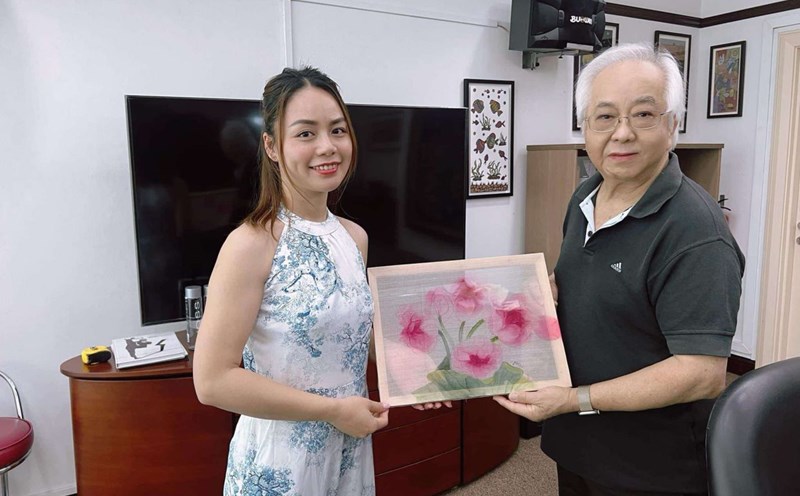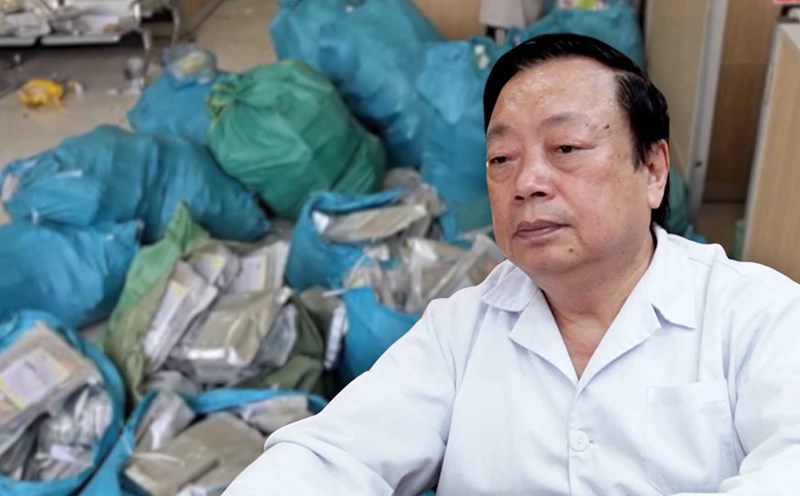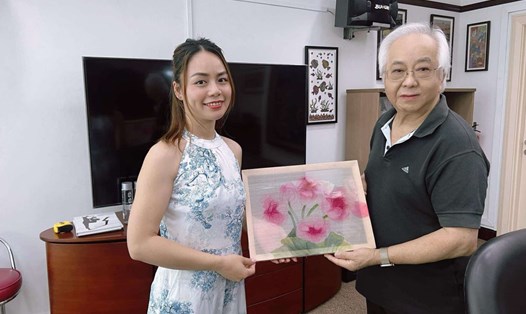It is no coincidence that the exhibition's name mentions Spring, because March is a special month - associated with birthdays, which is also the artist's death anniversary. 2025 marks the 50th anniversary of National Reunification, and he is one of the honored to contribute to that achievement.
1. The exhibition includes more than 200 paintings displayed in 4 exhibition rooms of the Vietnam Fine Arts Museum, although only a part of the artist's creative career, it can give viewers a vision of the artist's artistic work. From paintings to graphic works, paintings with iron pencils, grape ink, watercolor, engraving, oil painting, etc., Le Lam uses a very flexible and diverse method.
From poetic and lyrical scenery to paintings with many characters, with clear message content - every aspect of Le Lam leaves its mark. Viewers at the same time see his poetic soul, love for beauty and the spirit of the entire Revolution, before and after as one in him.
After finishing his studies in the Soviet Union and teaching at the Industrial Fine Arts School for 1 year, in 1965 artist Le Lam volunteered to join the Southern battlefield. In the video answering an interview with director Edison in 1981, the artist shared very sincerely and emotionally about the trip, which is his deep wish. He just didn't think the journey to the South and then back to the North would last for a few years until nearly 10 years (from 1965 to 1974).
Going to the South, for him, is following the call to serve the people of Vietnam, and then having documents to compose about the resistance war against the US of the people of Southern Vietnam. His belongings are pens, paper, color, flute in his backpack, poems, folk melodies of the North... To be able to use that art to serve soldiers at any time, his people are all happy and ready.
Slightly young, carrying on his back a luggage weighing about 20kg or less, sometimes up to 35 - 36kg, crossing the Truong Son road with many high mountains, deep forests, rivers and streams, passing through many enemy strongholds, after nearly 5 months, he finally reached the South.
The land has erased his original misconception that facing bombs and bullets will make people suffer, weak and weak, and have little joy. On the contrary, even though the air groups are like " full-eaters" spreading chemicals to destroy forests, "immense bowl-fried coconut gardens" that make "the most severely damaged green", here, he still sees "healthy people, even the Southern girls are very beautiful".
very quickly, in just 3 - 4 months, Le Lam got used to life and "lived normally like all the people in Southern Vietnam". He was able to distinguish between each type of plane, which type should be dropped with bombs, or which shells should be fired at him.
During the day, there are conditions for artists to paint, at night, they organize cultural activities or exhibition exhibitions for comrades, explorers, women's clubs and people to come and see. The exhibition paintings are clipped with bamboo strings, sometimes 50 - 70 pieces, sometimes 200 - 300 pieces.
The Everlasting Spring is his 6th solo exhibition in peacetime, but the exact number of his solo exhibitions throughout the war period could not be counted by him.
2. When the war passed, peace returned, the country was unified, and had time to look back, perhaps many people were in the mood of seeing that Vietnamese art was too far from the world. Many people wonder "Art of art" or "Art of humanity"? The work focuses on the first form or the first content and idea? And, does residential art of socialism have more historical value than its artistic value?
22 art students of the Resistance course (1950 - 1953) - a special course lacking many means of life, art, and school facilities, but is the most closely associated course, closest to the people. Painter Ngoc Linh said that every meal there is only 1 bowl of rice and tomatoes, it is a long time since there is meat, students at the people's house help the people increase and improve production. Students and teachers go to paint together, even calling each other "brother - sister" as if they were family members.
In the lesson, names like Manet, Renoir, Gauguin, Matisse... (pioneering artists of the impressionist school, post-impressive...) were also mentioned by the teacher. However, closely following the reality of life with the policies and movements of that time such as "production, thrift", fighting to reduce taxes was both the task of Fine Arts students, and giving them more capital to live on to paint and serve the people. Everyone has the thought: Eating people's meals is served, returning gratitude to the people.
Participating in the Revolution since the age of 14, artist Le Lam must have understood the lives of the people, especially the poor. The ideals of a citizen are probably not far from the ideals of an artist. His commitment to the war in the South is a call for harmony between the heart and the country, with art. That is an unaying, calculated dedication, first and then again.
We often talk about the vision beyond the times, looking far and wide, but we sometimes forget that every person born is associated with a certain era and bound by it. The beliefs and ideals of a person or a generation cannot be simply commented on and evaluated if their living context is ignored. Taking on talent, heart and sincerity of oneself to live and create works, there is no right - wrong, better - worse, no matter whether for humanity or for art, or separating form from content.
3. Like painters of the same period, and painters who grew up during the war, through the remaining works (not all of them), we can clearly see the dedicated attitude and appreciation of the work and profession of artist Le Lam. The documents of thousands of sketches and accompanying paintings carefully and in detail that he brought back to Hanoi in 1974 are an indescribable joy.
This 215 paintings can be said to be 215 pages of diaries, and naming them does not make it difficult for his family. The paintings "Ao Viel", " Dinh Duong", "Phong Quan Quoc Quoc" to "Marching in Truong Son Forest", "Dai Hoa Dai Long", "Saigon calm and brave June 19, 1968", "The Great Storm of the General Assault of Ben Tre", "Rising", "Defending the People's Power", "For a spring of intertwinity", "For Continuous attacks and Uprising", "Marching Up to win all will come back to us", "Dedicated to the front line", "Peaceful gardening", "Song of Hope", "Determination to protect each piece of land of the Fatherland" ... are always noted with pictures, words, and exercises from day to day. Seeing each painting, whether it is a sketch, an sketch, or a work, the viewer feels like returning to memories, even though I am absen during those years.
Along with music and literature, painting is an equivalent to showing us a part of the history of our nation that we have gone through - made by many people who are determined and determined with a spirit of both being determined and steadfast in the face of beauty, being determined to fight against wrong, destructive and violent actions in the homeland of a beautiful country.
If I were asked an artist, he would certainly not regret the time he has gone through, trusted and contributed. In a video answering an interview in 1981, he said that in 1974, when he returned, the streets of Hanoi welcomed him with a rain, with "a feeling of not knowing how to talk about happiness, after 10 years..." that he had "served the people of the South a lot", and at the same time "took out a treasure trove of paintings to follow".
Only then, when he returned to his hometown in Dong Anh, mistakenly staying next to a neighbor's house, thinking that his family was shocked, meeting relatives and children again, did he cry...
Many blue colors of Eternal Spring that we watch, are done with enthusiasm, joy, shock, and even those tears...











